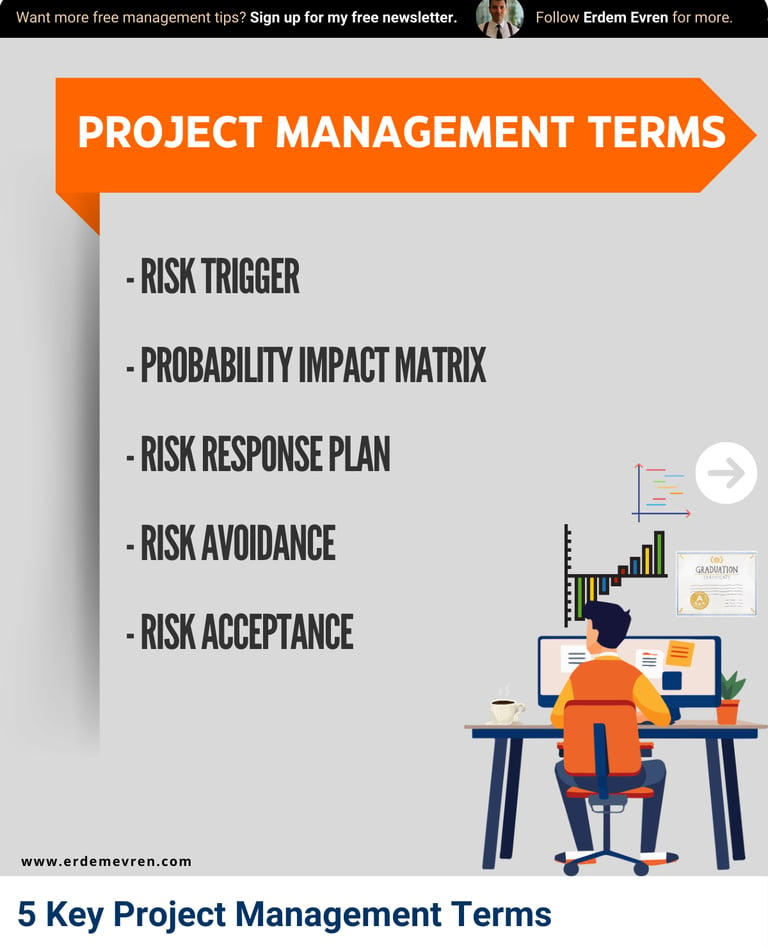Risk Management in Project Management: Key Terms & Best Practices
Concise yet insightful!


🚀 𝟱 𝗞𝗲𝘆 𝗣𝗿𝗼𝗷𝗲𝗰𝘁 𝗠𝗮𝗻𝗮𝗴𝗲𝗺𝗲𝗻𝘁 𝗧𝗲𝗿𝗺𝘀 𝗬𝗼𝘂 𝗡𝗲𝗲𝗱 𝘁𝗼 𝗞𝗻𝗼𝘄 & 𝗛𝗼𝘄 𝘁𝗼 𝗔𝗽𝗽𝗹𝘆 𝗧𝗵𝗲𝗺!
Understanding and applying key project management concepts is essential for successfully navigating risks and achieving project goals. Here’s a breakdown of 5 critical terms and how you can use them effectively in your projects:
1️⃣ 𝗥𝗶𝘀𝗸 𝗧𝗿𝗶𝗴𝗴𝗲𝗿
A risk trigger is an event or condition that signals the potential occurrence of a risk.
🔹 How to Use: Proactively identify these triggers during the planning phase. For example, a supplier delay could trigger a budget overrun. Keep a close eye on these triggers to take preemptive action before risks materialize.
2️⃣ 𝗣𝗿𝗼𝗯𝗮𝗯𝗶𝗹𝗶𝘁𝘆 𝗜𝗺𝗽𝗮𝗰𝘁 𝗠𝗮𝘁𝗿𝗶𝘅
This matrix helps assess the likelihood and impact of potential risks, allowing you to prioritize them based on severity.
🔹 How to Use: Create a matrix with two axes—probability and impact. Rank each risk accordingly and focus on high-probability, high-impact risks first. For example, if equipment failure is likely and could cause significant delays, it should be at the top of your list.
3️⃣ 𝗥𝗶𝘀𝗸 𝗥𝗲𝘀𝗽𝗼𝗻𝘀𝗲 𝗣𝗹𝗮𝗻
A Risk Response Plan outlines specific actions to take when a risk occurs, ensuring your team is prepared to handle uncertainties.
🔹 How to Use: Draft detailed response plans for each high-priority risk, including who is responsible for mitigating it. Ensure that your team has access to the plan and knows how to implement it if a risk occurs. For example, have a contingency plan in place for key supplier delays, like identifying backup suppliers.
4️⃣ 𝗥𝗶𝘀𝗸 𝗔𝘃𝗼𝗶𝗱𝗮𝗻𝗰𝗲
This involves eliminating the risk entirely by adjusting your project approach.
🔹 How to Use: Adjust your project plan to avoid risks altogether. For instance, if a certain vendor’s delay history could impact your project, you could switch to a more reliable vendor, even if it costs slightly more. Risk avoidance is especially useful in the early stages of project planning.
5️⃣ 𝗥𝗶𝘀𝗸 𝗔𝗰𝗰𝗲𝗽𝘁𝗮𝗻𝗰𝗲
Acknowledging that some risks cannot be avoided or mitigated, and choosing to accept them without further action.
🔹 How to Use: Accept risks that have a low probability of occurring or minimal impact. For example, if there’s a 5% chance of minor software bugs during testing, you may choose to accept this risk rather than spending significant resources to eliminate it. Ensure your team is prepared to deal with these risks if they do arise.
